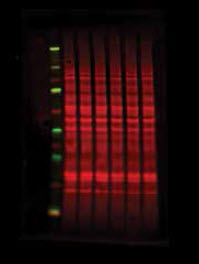Western Blotting: A Go-To Tool for Identifying Proteins in Pharmaceutical Studies
Western blotting separates proteins by size and shape with an electric field applied to a gel, and then targeted proteins are stained with antibodies
Western Blotting Remains a Go-To Tool That Keeps Getting Easier
In 1979, Harry Towbin of the Friedrich Miescher Institute for Biomedical Research in Basel, Switzerland, and his colleagues Theophil Staehelin and Julian Gordon published an article in the Proceedings of the National Academy of Sciences of the United States called “Electrophoretic transfer of proteins from polyacrylamide gels to nitrocellulose sheets: procedure and some applications.” This launched a protein-identification technique known as Western blotting, and 54,126 papers have cited Towbin and company’s original publication— according to Google Scholar on September 3, 2016. That number of citations alone gives anyone an idea of this technique’s value to molecular biology.
Related Article: How It Works: A New Approach to Western Blotting
In brief, Western blotting separates proteins by size and shape with an electric field applied to a gel, and then targeted proteins are stained with antibodies. Also, there’s really nothing “western” about it; the name just emerged from a twist on the name Southern blotting, which is used to detect DNA.
Scientists around the world continue to use Western blotting in basic and applied research, such as pharmaceutical studies. In particular, this molecular technique can reveal how disease emerges, how it spreads, and ways to defeat it. Most important, new techniques make it possible to apply Western blotting in simpler ways that provide more accuracy than ever. Furthermore, new tools make it possible for scientists to use the bulk of Western-blotting knowledge that is available in the literature. These advances keep this tool more relevant than ever.
Understanding Addiction
At the University of Florida in Gainesville, assistant professor of psychology Lori Knackstedt studies how addictive drugs can change the brain. “One easy way to do that is to have animals take the drugs, and then we do Western blots to look for changes in proteins related to neurotransmitters and receptors related to drug addiction,” she explains. “Then, we try to fix the brain with medications to see if they can normalize those proteins.”
Western blotting, says Knackstedt, is the easiest way to look at protein levels. Alternatively, a scientist could use immunohistochemistry on brain slices. “That takes longer, and it’s technically harder,” she explains. “So Western blotting is usually picked for its simplicity.”
She points out that many companies make antibodies that can be used in Western blotting. “The biggest concern is: Does the antibody recognize what you think it does?” Knackstedt asks. “Very few people check.” That requires using an animal that doesn’t have the gene that makes the protein of interest—a so-called knockout animal—and then adding the antibody, which should bind to nothing.
So when asked what tools she’d like, Knackstedt says, “validated antibodies.” She adds that right now she “does the knockout studies or uses an antibody where someone else has.”
Measuring Molecular Consequences
When searching for new pharmaceuticals, scientists face several challenges. For one thing, the drug must work— meaning that it shows efficacy for the condition that it is planned to treat—and scientists need to unravel the mechanism of action. To truly understand how a drug works, scientists must explore the molecular consequences of administering it, and Western blotting can be used in such studies.
For example, a research team from the University of Texas MD Anderson Cancer Center in Houston used Western blotting to study various reactions to buparlisib (BKM120) in patients with leukemia. In brief, BKM120 inhibits phosphatidylinositol-3-kinase (PI3K), which is part of a signaling pathway that controls the growth and proliferation of leukemia. According to the U.S. National Cancer Institute, BKM120’s impact on PI3K “may result in inhibition of tumor cell growth and survival in susceptible tumor cell populations.”
Related Article: Body’s Own Gene Editing System Generates Leukemia Stem Cells
Naval G. Daver, assistant professor in MD Anderson’s department of leukemia, and his colleagues conducted a Phase I trial in leukemia patients to determine the dose-limiting toxicity of BKM120. Using Western blotting, they showed inhibition of disease markers above 50 percent in more than half of the patients, as reported in the American Journal of Hematology in 2016.
Even when researchers find drugs that work for illnesses, that doesn’t mean they will always work. Diseases, including leukemia, can grow resistant to a treatment that initially proved effective in a patient. As an example, a team of Chinese scientists studied drug resistance in acute myeloid leukemia (AML) and described their findings in a 2014 issue of PLoS One (now PLOS ONE) (doi: 10.1371/journal.pone.0105381). As the scientists wrote: “Drug resistance still represents a major obstacle to successful acute myeloid leukemia treatment, and the underlying mechanism is not fully elucidated.” Their work revealed that overexpression of a regulatory gene, c-Myc, can spawn the resistance to a chemotherapeutic drug. Using Western blotting— plus polymerase chain reaction techniques—these scientists revealed that overexpression of c-Myc reduced a family of binding proteins and that increasing these same proteins could return the efficacy of an AML drug. And they concluded: “Thus, our study indicated that c-Myc could be a novel target to overcome drug resistance, providing a new approach in AML therapy.” For many cancer patients, finding ways to extend the efficacy of a therapy means the difference between life and death, and understanding the molecular nuances that drive or disrupt resistance helps pharmaceutical scientists provide these lifesaving treatments.
Adding Accuracy
 This Jurkat cell lysate was stained with REVERT Total Protein Stain and detected in the 700 nanometer channel of the Odyssey CLx imaging system.Image courtesy of LI-COR BiosciencesTo improve accuracy, scientists often normalize proteins detected in a Western blot. The REVERT Total Protein Stain from LI-COR Biosciences (Lincoln, NE) makes that easier.
This Jurkat cell lysate was stained with REVERT Total Protein Stain and detected in the 700 nanometer channel of the Odyssey CLx imaging system.Image courtesy of LI-COR BiosciencesTo improve accuracy, scientists often normalize proteins detected in a Western blot. The REVERT Total Protein Stain from LI-COR Biosciences (Lincoln, NE) makes that easier.
This product, says Kristi Ambroz, the company’s director of customer solutions and support, “stains all membrane-bound proteins, allowing normalization of the target protein to the total protein content within the sample, and thus enhancing quantitative accuracy.” She adds, “The stain can be detected in the 700 nanometer channel of Odyssey imaging systems for quantification and normalization analyses.” After reversing the staining, a Western blot detects the proteins of interest.
“Normalizing the target protein utilizing this reagent reduces the impact of biological variability as compared to a single housekeeping protein resulting in more accurate quantification of protein expression in a Western blot,” Ambroz explains.
Scientists who need to quickly develop reproducible processes might prefer a stain-free approach to Western blotting. As explained by Raymond R. Miller, product manager at Bio-Rad Laboratories (Hercules, CA), his company’s “Stain-Free Western Workflow doesn’t require staining steps, reduces variability, and allows the researcher to track the quality of the process, providing higher confidence in the results.” He adds, “Coupled with our validated antibodies and Total Protein Normalization protocol, the Stain-Free Workflow benefits scientists, especially those working in pharmaceutical drug discovery and development where optimizing time-to-result and ensuring reproducibility are critical and become even more significant in the later stages of manufacturing and quality control.”
Simplified Steps
Some approaches to Western blotting make it easier than ever. ProteinSimple (San Jose, CA), for example, makes products developed from its Simple Western technology. “This requires no gels and very little hands-on intervention,” says Patricia Piatti, product manager for Simple Western. “Everything is done automatically after sample preparation and loading.” This approach to identifying proteins uses capillary electrophoresis followed by immunodetection.
 ProteinSimple’s Simple Western reduces the handson steps in this protein analysis.Image courtesy of ProteinSimpleThe Wes™ platform handles up to 24 samples and runs them through Western processing in less than three hours. Doing that with the traditional approach, says Piatti, would take two mini-gels and typically at least 24 hours. “Our approach also uses less sample than traditional Westerns,” she says.
ProteinSimple’s Simple Western reduces the handson steps in this protein analysis.Image courtesy of ProteinSimpleThe Wes™ platform handles up to 24 samples and runs them through Western processing in less than three hours. Doing that with the traditional approach, says Piatti, would take two mini-gels and typically at least 24 hours. “Our approach also uses less sample than traditional Westerns,” she says.
It also automatically processes the data. “All the quantitation— signal and molecular weight—has been done for you,” Piatti says. The automation of the process and data analysis also reduce results variability and the expertise needed to use this technology. “No calibration is necessary before or after a run,” she explains, “and there’s very little waste generated, which leaves nothing to clean up.”
Antibody Identification
Based on having performed many Western blots, Karin Lachmi, cofounder and CSO at Bioz (Palo Alto, CA), says, “One of the main problems is identifying the right antibody for the right assay.”
A scientist can easily search a few articles to get some background, but Lachmi wanted more. She wanted all the information that’s out there; she wanted to make well-informed decisions. So now a scientist can go to Bioz (www.Bioz.com), enter the name of an antibody, and get back information summarized and structured from millions of articles. “The results present you with a complete list of all vendors who sell the antibody that you are looking for, and help you identify the best antibody vendor for your assay,” Lachmi explains. “You’ll see whether other researchers use this antibody for Western blotting or if it’s better for ELISAs.”
Related Article: Speed and Accuracy Required for Automating Immunoassays
Each antibody gets a “Bioz Star” rating, based on a set of weighted parameters, including mentions in articles, impact factor, and recency. “This really helps you understand the quality of the product and its likelihood to work well in your experiment,” she says. “And it’s a free search engine for any researcher to use.”
 The Bioz free search engine helps scientists find the right antibodies for their Western blotting.Image courtesy of BiozAs Daniel Levitt, Bioz cofounder and CEO, says, “Our tool allows researchers to make sure that the way they are performing an assay is a good match to how other researchers have performed it successfully.” He adds, “This is a guide prepared by millions of other researchers who have already invented the wheel, and we’ve summarized this valuable data for the benefit of the next researcher.”
The Bioz free search engine helps scientists find the right antibodies for their Western blotting.Image courtesy of BiozAs Daniel Levitt, Bioz cofounder and CEO, says, “Our tool allows researchers to make sure that the way they are performing an assay is a good match to how other researchers have performed it successfully.” He adds, “This is a guide prepared by millions of other researchers who have already invented the wheel, and we’ve summarized this valuable data for the benefit of the next researcher.”
With the right platform and information, Western blotting can reveal and characterize potential medicines. From exploring addiction to drug efficacy, as well as the development of resistance, this molecular technique remains a pharmaceutical workhorse. The key arises from the detail that this technique can provide. Moreover, new methods make this technique easier and faster, and databases help scientists select the best antibodies to use in specific experiments. So even after more than 35 years, Western blotting promises to continue as a cutting-edge mainstay in molecular labs, especially ones working on ways to improve and extend our lives.

